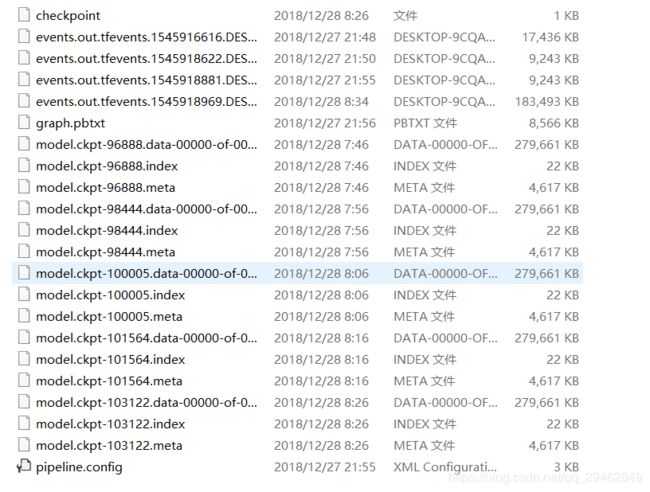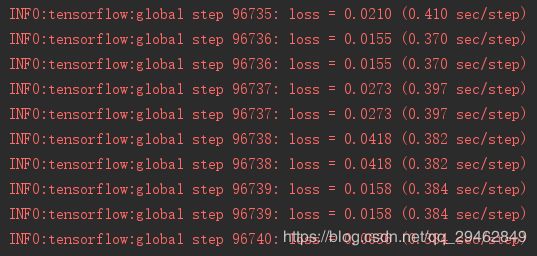python训练Faster RCNN&&C++调用训练好的模型进行物体检测-基于opencv3.4.3(超详细)
介绍
上一篇博文讲到tensorflow Object Detection api 基于SSD模型对数据进行训练,然后通过C++版本的opencv进行调用,但是通过实验发现,SSD虽然快但是准确率实在太低了,所以又重新使用Faster RCNN进行重新训练~废话不多说了,开始主要内容介绍了!
训练阶段
配置:GTX1060、I7-8700k~
关于object detection api的配置使用就不多说了,详细请参考:
https://blog.csdn.net/zong596568821xp/article/details/82015126
https://blog.csdn.net/chuquanchang1051/article/details/79804965
这里是基于faster_rcnn_resnet50_coco模型,下载链接见:faster_rcnn_resnet50_coco_2018_01_28,下载之后解压,解压后的文件如下图所示:

当解压模型后,这时需要到object_detection/samples/configs/文件夹中找到对应的config文件,这里是faster_rcnn_resnet50_coco.config文件,打开config文件,在这里我修改了它的类别数目,由于这里只有一种garbage类别,所以num_classes=1。
model {
faster_rcnn {
num_classes: 1 //有几种类别就写几种
image_resizer {
keep_aspect_ratio_resizer {
min_dimension: 600
max_dimension: 1024
}
除此之外,还需要配置一些文件目录,其中fine_tune_checkpoint就是下载模型中的model.ckpt,input_path和label_map_path就是训练数据和标签,其中object-detection.pbtxt是自己建立的文件,记录着自己的标签信息,因为这里只有一种类别,格式如下:
item {
id: 1
name: 'garbage'
}
use_moving_average: false
}
gradient_clipping_by_norm: 10.0
fine_tune_checkpoint: "model_zoo/faster_rcnn_resnet50_coco_2018_01_28/model.ckpt"
from_detection_checkpoint: true
# Note: The below line limits the training process to 200K steps, which we
# empirically found to be sufficient enough to train the pets dataset. This
# effectively bypasses the learning rate schedule (the learning rate will
# never decay). Remove the below line to train indefinitely.
num_steps: 200000
data_augmentation_options {
random_horizontal_flip {
}
}
}
train_input_reader: {
tf_record_input_reader {
input_path: "train_data/garbage/train/tf_record/train.record"
}
label_map_path: "model_zoo/faster_rcnn_resnet50_coco_2018_01_28/object-detection.pbtxt"
}
eval_config: {
num_examples: 116 #测试集的数据数量,需要修改下
# Note: The below line limits the evaluation process to 10 evaluations.
# Remove the below line to evaluate indefinitely.
max_evals: 10
}
eval_input_reader: {
tf_record_input_reader {
input_path: "train_data/garbage/test/tf_record/test.record"
}
label_map_path: "model_zoo/faster_rcnn_resnet50_coco_2018_01_28/object-detection.pbtxt"
shuffle: false
num_readers: 1
}
修改完配置文件之后,回到object detection api的train.py文件中,train.py文件原来在legacy文件夹中,将其复制出来即可。在train.py文件中,修改以下两项内容:
#模型保存路径
flags.DEFINE_string('train_dir', default='training_model/garbage/',help='')
#修改过的配置文件.config路径
flags.DEFINE_string('pipeline_config_path', default='samples/configs/faster_rcnn_resnet50_coco.config',help='')
模型的转换
当训练结束后,需要把训练好的模型转换为.pb文件,下图为训练生成的文件。

转换文件为export_inference_graph.py,源代码如下所示,其中转换的模型要为最好的模型:
import tensorflow as tf
from google.protobuf import text_format
from object_detection import exporter
from object_detection.protos import pipeline_pb2
slim = tf.contrib.slim
flags = tf.app.flags
flags.DEFINE_string('input_type', 'image_tensor', 'Type of input node. Can be '
'one of [`image_tensor`, `encoded_image_string_tensor`, '
'`tf_example`]')
flags.DEFINE_string('input_shape', None,
'If input_type is `image_tensor`, this can explicitly set '
'the shape of this input tensor to a fixed size. The '
'dimensions are to be provided as a comma-separated list '
'of integers. A value of -1 can be used for unknown '
'dimensions. If not specified, for an `image_tensor, the '
'default shape will be partially specified as '
'`[None, None, None, 3]`.')
flags.DEFINE_string('pipeline_config_path', 'samples/configs/faster_rcnn_resnet50_coco.config',
'Path to a pipeline_pb2.TrainEvalPipelineConfig config '
'file.')
flags.DEFINE_string('trained_checkpoint_prefix', 'training_model/garbage/model.ckpt-103122',
'Path to trained checkpoint, typically of the form '
'path/to/model.ckpt')
flags.DEFINE_string('output_directory', 'pb_model/faster_rcnn_resnet50_coco', 'Path to write outputs.')
flags.DEFINE_string('config_override', '',
'pipeline_pb2.TrainEvalPipelineConfig '
'text proto to override pipeline_config_path.')
flags.DEFINE_boolean('write_inference_graph', False,
'If true, writes inference graph to disk.')
tf.app.flags.mark_flag_as_required('pipeline_config_path')
tf.app.flags.mark_flag_as_required('trained_checkpoint_prefix')
tf.app.flags.mark_flag_as_required('output_directory')
FLAGS = flags.FLAGS
def main(_):
pipeline_config = pipeline_pb2.TrainEvalPipelineConfig()
with tf.gfile.GFile(FLAGS.pipeline_config_path, 'r') as f:
text_format.Merge(f.read(), pipeline_config)
text_format.Merge(FLAGS.config_override, pipeline_config)
if FLAGS.input_shape:
input_shape = [
int(dim) if dim != '-1' else None
for dim in FLAGS.input_shape.split(',')
]
else:
input_shape = None
exporter.export_inference_graph(
FLAGS.input_type, pipeline_config, FLAGS.trained_checkpoint_prefix,
FLAGS.output_directory, input_shape=input_shape,
write_inference_graph=FLAGS.write_inference_graph)
if __name__ == '__main__':
tf.app.run()
这和最初下载的模型非常相似,但是里面的结构有所不同。opencv在调用faster rcnn等物体检测模型时,还需要一个.pbtxt文件,它可以告诉函数该怎么读取模型,该转换由tf_text_graph_faster_rcnn.py来完成。
详细请参考https://github.com/opencv/opencv/wiki/TensorFlow-Object-Detection-API#generate-a-config-file,该文件在opencv的dnn模块中,下载链接:dnn模块,下载完之后放到object_detection文件夹下即可。
需要修改的地方有input、output、config、num_classes,如果没有num_classes,可以将其加上,也可以不加,.config文件中包含这项。
if __name__ == "__main__":
parser = argparse.ArgumentParser(description='Run this script to get a text graph of '
'Faster-RCNN model from TensorFlow Object Detection API. '
'Then pass it with .pb file to cv::dnn::readNetFromTensorflow function.')
parser.add_argument('--input', default='F:/tensorflow_object_detection/object_detection/pb_model/faster_rcnn_resnet50_coco/frozen_inference_graph.pb',help='Path to frozen TensorFlow graph.')
parser.add_argument('--output', default='F:/tensorflow_object_detection/object_detection/pb_model/faster_rcnn_resnet50_coco/faster_rcnn.pbtxt',help='Path to output text graph.')
parser.add_argument('--config',default='F:/tensorflow_object_detection/object_detection/samples/configs/faster_rcnn_resnet50_coco.config',help='Path to a *.config file is used for training.')
# parser.add_argument('--num_classes', required=True, default=1,help='Path to a *.config file is used for training.')
args = parser.parse_args()
createFasterRCNNGraph(args.input, args.config, args.output)
转换完成之后会生成faster_rcnn.pbtxt文件,然后就交给C++调用吧!除了C++,还有一个opencv-python版本的测试程序:
import cv2 as cv
cvNet = cv.dnn.readNetFromTensorflow('C:/Users/18301/Desktop/faster_rcnn_resnet50_coco/frozen_inference_graph.pb',
'C:/Users/18301/Desktop/faster_rcnn_resnet50_coco/faster_rcnn.pbtxt')
img = cv.imread('C:/Users/18301/Desktop/images/image12.jpg')
rows = img.shape[0]
cols = img.shape[1]
cvNet.setInput(cv.dnn.blobFromImage(img, size=(300, 300), swapRB=True, crop=False))
cvOut = cvNet.forward()
print(cvOut)
for detection in cvOut[0,0,:,:]:
score = float(detection[2])
if score > 0.3:
left = detection[3] * cols
top = detection[4] * rows
right = detection[5] * cols
bottom = detection[6] * rows
cv.rectangle(img, (int(left), int(top)), (int(right), int(bottom)), (23, 230, 210), thickness=2)
cv.imshow('img', img)
cv.waitKey()
Opencv调用Faster RCNN源代码
#include
#include
#include
#include 注意:cv::Mat blob = cv::dnn::blobFromImage(frame, 1, Size(inWidth, inHeight), false, true);这里会导致faster rcnn检测结果乱码,自己也是查了好久才发现,按这个格式来,亲测有效!
这里的宽度和高度不能太小了,否则识别率会降低,但是大的尺寸会消耗比较多的时间,自己找一个折衷吧!
const size_t inWidth = 600;
const size_t inHeight = 600;
实验结果

